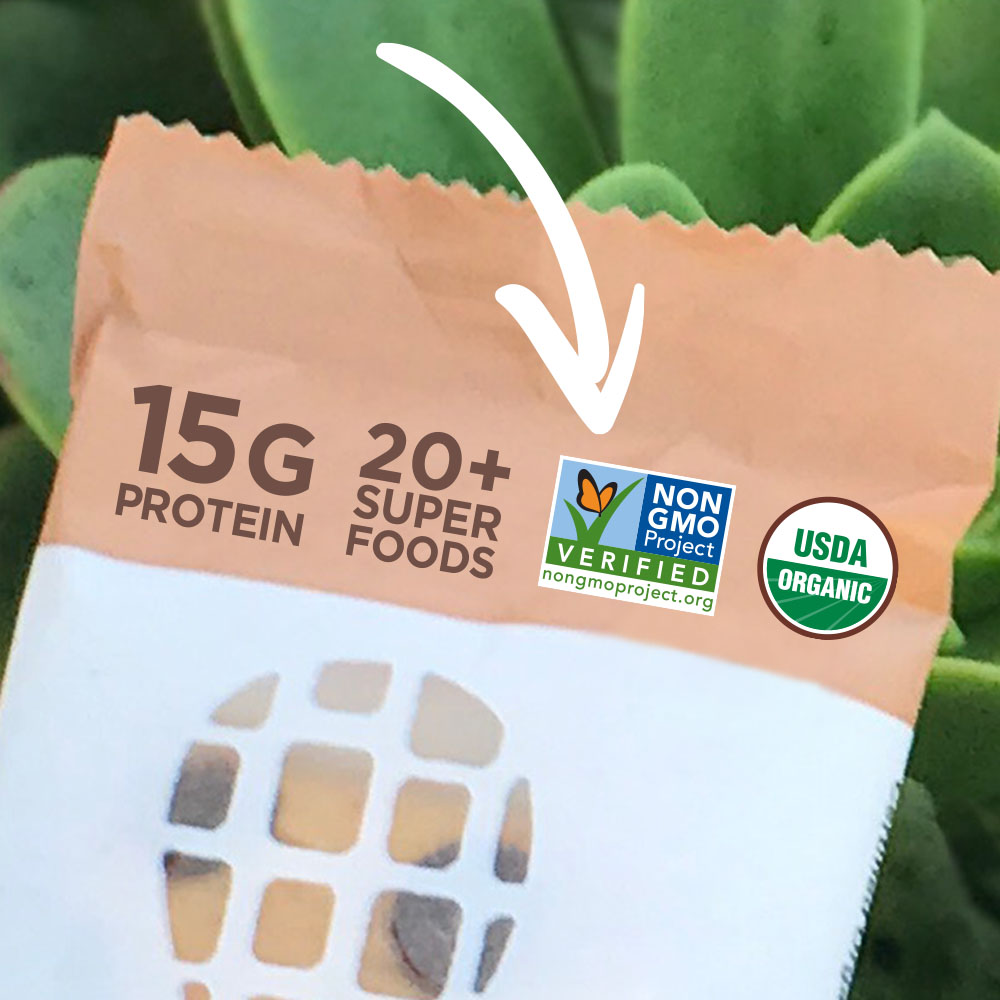You’ve probably noticed three letters controlling the food conversation lately: GMO.
During one lap around the grocery store you see dozens of food products wearing the Non-GMO Project Verified label like a badge of honor. From non-GMO protein bars, to vegetables, pasta and poultry, it seems all food categories are pivoting to exclude genetically modified ingredients from production. The rise of transparent food labeling is a movement that represents the public’s right to know what we’re putting in our bodies.
So, what does it all mean? Are GMOs safe? Should I only serve non-GMO food to my kids? Are there proven health risks? I heard they were saving the world’s food problem, is that true?
The GMO debate is a sensitive subject, and you may be surprised to find that even your closest friends have different opinions on the issue. Here at Perfect Bar, we’re committed to clean whole food ingredients and clear nutrition labels, and we’re proud to offer fresh protein bars free of GMOs. But we’re not going to tell you what to believe. Instead, we’re going to dissect the issue and help you discover where you fall on the GMO spectrum.
GMOs: What Are Genetically Modified Organisms?
Plain and simple GMOs are organisms that have had their characteristics changed through the modification of their DNA, whereas such modification would not occur naturally. Sounds a little science-y, but that’s just the thing – it is science!
The modification process is done in a lab setting, not out in the field where food naturally grows. Think beakers and measuring cups you last used in high school chemistry class. In the American food system, such modifications are usually to withstand herbicides or pesticides, draught or extreme weather, making it easier to grow mass quantities of crops that yield higher results. That’s good for business, but disruptive to the natural farming ecosystem.
Okay, so we know that the food system has changed. But, what is the current impact? Nearly 75 to 80 percent of food consumed by Americans contains GMOs. Whoa, that’s major.
Whether you are for GMOs, against GMOs or undecided, we can all unite for a common cause of open communication. As consumers, we have a right to know what we’re putting in our bodies. An efficient way to educate the public is through clear, identifiable food labeling.
Organic and Non-GMO: What’s the Difference?: Organic ingredients are always non-GMO, as the absence of genetically modified organisms is one of the criteria in certification. But, organic does not automatically mean Non-GMO Project Verified. The largest difference is the farming practices – GMO speaks to the seed being genetically modified, whereas organic further restricts pesticide, herbicide or insecticide use, and monitors land conditions.
Although it’s a complicated issue, the shopping direction is very clear. If you want to avoid genetically modified organisms in the food you buy, follow the butterfly.
Non-GMO Food Labels: What Does That Butterfly Mean?
The Non-GMO Project was founded in 2007 in an attempt to alleviate the general confusion around genetically modified organisms. Two grocer pioneers – the Natural Grocery Company in Berkeley, California and the Natural Food Market in Toronto, Ontario – joined together to launch the Non-GMO Project with one goal in mind: to create a “standardized definition for non-GMO products in the North American food industry.”

The Non-GMO Project’s butterfly label appears on packaging to signal that a food product is Non-GMO Project Verified – the ultimate certification. If you see the butterfly label, you can be confident that food product is completely free of GMOs.
With global support, extensive scientific research and an expanded board of directors, the Non-GMO Project grew steadily, and by 2010 the first products to be marked with the butterfly label hit shelves. Today, Non-GMO Project Verified is the fastest growing food label in the United States, with more than 3,000 verified brands in grocery stores nationwide (including Perfect Bar!).
Why a Butterfly? The butterfly seal represents the relationship between the food we eat and the world we live in. According to the Non-GMO Project, the monarch butterfly is a victim of the increase in genetically modified crops and subsequent increased pesticide use.
GMO Blurred Lines: The Public’s Right to Know
As the GMO debate continues, we remain committed to transparent labeling on all food products. And we’re not alone. Non-GMO labeling is a movement with legislative backing.

You may remember some of the louder rumblings from 2016 when Congress passed a GMO labeling law making it necessary to label food products containing any GMOs. Resulting regulations will roll out in the coming years, but with loopholes lingering, GMO food labeling could be still unclear.
But don’t be discouraged, progress is persevering. The confusion continues to be a catalyst for change and fuel for the Non-GMO Project’s mission.
In the meantime, remember the golden rule: If you choose to avoid GMOs, follow the butterfly when shopping in grocery stores across the country.
The GMO Debate: What Are the Pros and Cons?
To help you better understand the debate, we’re breaking down the pro-GMO arguments and the anti-GMO rebuttals, because we think it’s important to hear both sides of the story.
Pro-GMO: The Argument
Here’s what they are saying:
- The process of modifying organisms has been happening since the beginning of time. Farmers have been crossbreeding in the fields since forever, and cross-pollination creates hybrid food. Tangelo anyone? Now, though, with the help of our trusty science lab, we can control other variables and make fruits and veggies even stronger.
- Scientists are saying GMOs are fine to eat, so what’s the drama? There is no evidence supporting that GMOs are unsafe for human consumption. National Academy of Sciences (same organization warning against climate change) released a pretty hefty study in 2016 doubling down on their initial assessment that GMOs are safe to eat.
Non-GMOs: The Rebuttal
“Sure, but what about…”
- …giving us the right to decide for ourselves?” The largest concern around genetically modified organisms isn’t the existence or safety of them, but more the accuracy of food labeling. The public wants to know if GMOs are in their food. Seems fair.
- …the lack of long-term studies?” GMOs have been around in America for 20+ years, with global cases suggesting modifications as early as the 1900s. But in the scientific research world, that is not a very long time and no one really knows what the lasting effects will be.
- …the environment and the workers of the land?” Regarding the assault on the land and workers rights, Non-GMO Project, the certifying body of non-GMO labels, warns: “More than 80 percent of all genetically modified crops grown worldwide have been engineered for herbicide tolerance. As a result, the use of toxic herbicides, such as Roundup®, has increased fifteen fold since GMOs were first introduced.”
The use of genetically modified organisms is a complex issue that has changed the American food system forever. At the end of the day, only you know what’s right for your family.
Why Our Non-GMO Protein Bars Are Perfect
At Perfect Bar, we believe in whole food nutrition, transparency in food labeling and clean, non-GMO ingredients as close to nature as we can find. Non-GMO practices have long been our priority. And now, we are proud to offer Non-GMO Project Verified* protein bars, with new packaging rolling out to stores across the country this fall. When it comes to our original refrigerated protein bar, you never have to substitute delicious for nutritious.
All Perfect Bar flavors are Non-GMO Project Verified.
Want more health hacks and wellness insights? We got you covered. You'll also receive a code for 15% off your first order!


do you sell a variety pack of the perfect bars